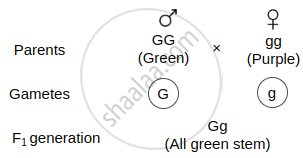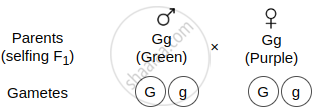Advertisements
Advertisements
प्रश्न
A green stemmed tomato plant denoted by (GG) is crossed with a tomato plant with purple stem denoted by (gg).
- What colour of the stem would you expect in their F1 progeny?
- In what ratio would you find the green and purple coloured stem in plants of F2 progeny?
- What conclusion can be drawn for the above observations?
उत्तर
(i) All the plants in F1 progeny will be of green coloured stem.

(ii) Cross for F2 progeny is:

F2 progeny -
| G | g | |
| G | Gg (Green) |
Gg (Green) |
| g | Gg (Green) |
gg (Purple) |
Phenotypic ratio = Green : Purple = 3 : 1
(iii) According to the finding above, purple stems are subordinate to green stems. Thus, according to the rule of dominance, only the dominant characteristic was present in F1. Purple stem in F2 indicates that the alleles for purple stem were inherited but were not expressed in F1, nevertheless. Only in F2 under homozygous circumstances did they get expressed.
APPEARS IN
संबंधित प्रश्न
State the three Mendel’s laws of inheritance.
Define the following:
Phenotype
Define the following:
Dominant
Predict the genotype and phenotype of the following cross in pea.
TT x Tt
(Capital letters show dominance)
Choose the correct answer:
The contrasting characters used by Mendel are called _____
Answer the following question.
Compare in any three ways the chromosomal theory of inheritance as proposed by Sutton and Bovery with that of experimental results on pea plant presented by Mendel.
Define Mendel’s law of segregation.
A typical Mendelian dihybrid ratio of F2 generation is 3:1.
Identify the percentage of recombinants in F2 generation in the following case.
In Morgan's experiment with Drosophila, the yellow-bodied white-eyed female was crossed with a brown-bodied red-eyed male and their F1 progeny were intercrossed.
In peas, tallness is dominant over dwarfness, and red colour of flowers is dominant over the white colour. When a tall plant bearing red flowers was pollinated with a dwarf plant bearing white flowers, the different phenotypic groups were obtained in the progeny in numbers mentioned against them:
Tall, Red = 138
Tall, White = 132
Dwarf, Red = 136
Dwarf, White = 128
Mention the genotypes of the two parents and of the four offspring types.
